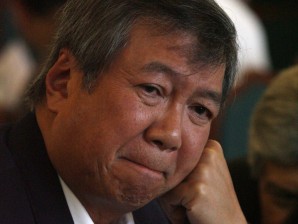The newly installed president and CEO of United Coconut Planters Bank (UCPB) on Tuesday vowed to lead the government-sequestered bank towards sustained expansion and profitability while beefing up support for coconut farmers.
Jeronimo Kilayko, 64, officially takes over the helm of UCPB Wednesday after its board of directors—represented by the Presidential Commission of Good Government, Philippine Deposit Insurance Corp. and coconut farmers’ groups—elected him on Tuesday as their new president and chief executive officer (CEO).
Speaking to reporters, Kilayko said he was a professional manager, rebutting concerns that he may be beholden to businessman Eduardo “Danding” Cojuangco.
“I’ve gone through the selection process of Malacañang and I feel I am a professional banker. It’s not my relationship with any person that put me here. It’s really my 30-year experience and I feel I can do something with the bank to help the government,” Kilayko said.
The banker said he thought long and hard when he learned that he was being considered for the post, since he was already semiretired.
“But I felt that there are so many programs I could develop to help P-Noy (Aquino), the government, by helping Filipino farmers,” Kilayko said.
Kilayko, who will take over from another veteran banker, Ramon Sy, is no stranger to UCPB as he previously served as chairman and CEO of this bank from 1998 to 2002.
He later joined the Cojuangco-led San Miguel group as head of the real estate unit San Miguel Properties and afterwards as vice chairman of Bank of Commerce when the San Miguel group took over a controlling stake in the bank.
Previously, Kilayko had also worked at the Manila branch of Bank of America as vice president and as executive vice president and head of banking sector at state-owned Land Bank of the Philippines.
Kilayco’s appointment was also criticized by some coconut farmers group and politicians amid allegations that P30 billion of UCPB’s assets had been squandered during the Estrada regime, when Kilayko was the UCPB chairman.
“I don’t think it’s fair just to look at it from my time,” Kilayko said, noting that the problematic loans were only inherited from the time UCPB was first sequestered after the ouster of the Ferdinand Marcos regime in 1986.
The banker also added that most of those loans no longer existed in the UCPB’s portfolio. He said there were still some problematic corporate loans as big as P6 billion—the remainder of those old problems—that the bank was still working on.
“There’s progress but it takes time to address these problems,” he said.
Some of these bad assets had been unloaded in the past via the special purpose vehicle framework but whatever is left will be appropriately addressed by a task force dedicated to work on it.
Moving forward, Kilayco vowed to tighten credit policy and be transparent in giving out loans. “We’ll make sure that all credit standards are followed.”
Under his leadership, he said UCPB would sustain profitability and no longer burden the government for any assistance.
The government made a P30-billion cash infusion into UCPB in 2008. Under the scheme, the government placed long-term deposits with the bank that were in turn invested in government securities. In 2003, the government provided at least P20 billion in cash advance to UCPB through the state-owned Philippine Deposit Insurance Corp.
The government has usually taken it upon itself to help UCPB because the bank is virtually the responsibility of the state—about 70 percent of its shares are under sequestration.
Being restricted by unresolved ownership claims, UCPB has little options in fund-raising unlike other commercial banks.
The bank has been the subject of a long-running ownership dispute involving coconut farmers and Cojuangco, a close associate of the Marcos family.
“While it’s a private bank, it’s government running it. I personally feel that it’s part of the problem,” Kilayko said, referring to the bank having to go through volatile political conditions whenever there’s a change in administration.
“And I really hope the ownership problem can be resolved,” he said.
While all banks are under pressure to shore up capital due to more stringent accounting and capital adequacy requirements, he noted that the most that UCPB could do for now would be to raise funds from the issuance of long-term negotiable certificates of deposits or other debt-like instruments like preferred shares.
“Our growth is really hampered by the fact that our capitalization is limited, but in terms of deposits we’re okay. Loans are also growing and in terms of income, we don’t see any problem,” he said.
To boost capitalization, the 183-branch UCPB has also consolidated its savings banking unit into its books and expanded its branch network but noted that it could not scale up in the same way as the likes of Banco de Oro and Metrobank.
Kilayco said UCPB could afford to open at least five new branches each year.
Kilayko said he would work to improve UCPB’s assistance to coconut farmers.
“We’ll help not only with money but in development. And if we do fund, it should be for something that the coconut industry needs like planting, to improve productivity,” he said.
“While we’re expanding the bank, we’ll emphasize our relationship with coconut farmers. I’m going to draw from my experience with Landbank to help coco farmers not only in giving loans but also nonloans like helping with the accounting system,” he said.
Compared to the situation during the Estrada administration when he chaired UCPB, Kilayko said the environment has become more challenging and competitive.
“Banking has become more technology-driven. Those are expenses that we have to incur but I’m confident that we can keep up with competitors,” he said.
He added that UCPB had improved its loan mix to increase consumer lending. Previously, the bank focused only on lending to corporations.
Kilayko vowed to work until he is 70 but stressed that he would “serve at the pleasure of the board.”
